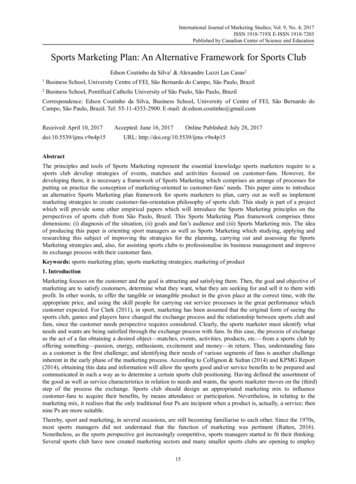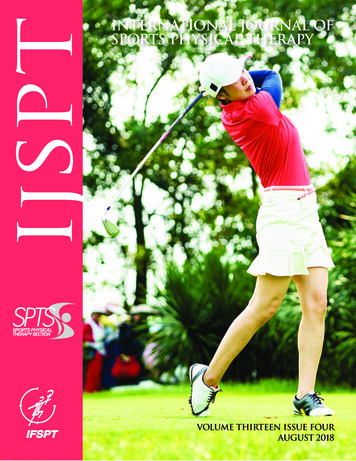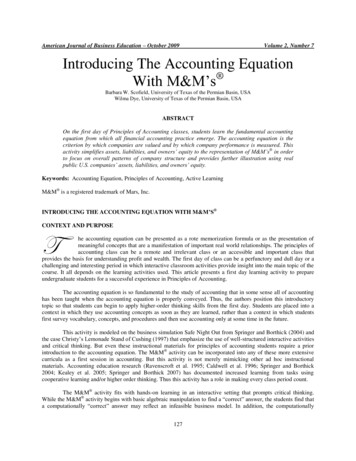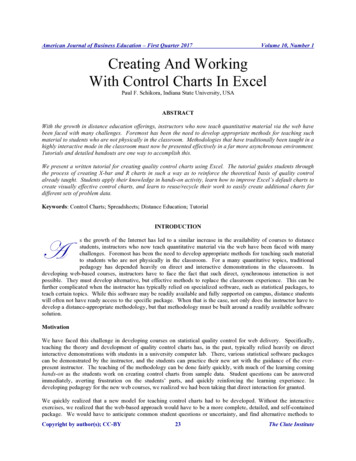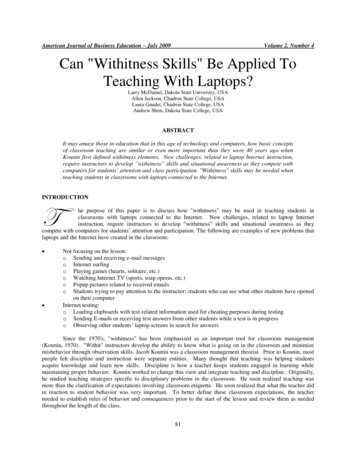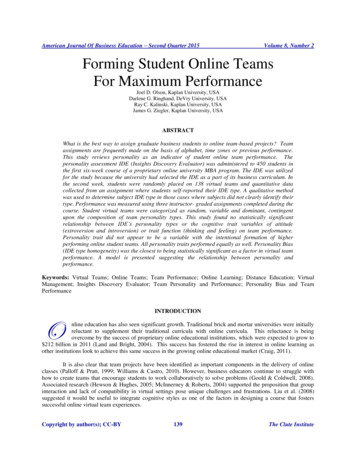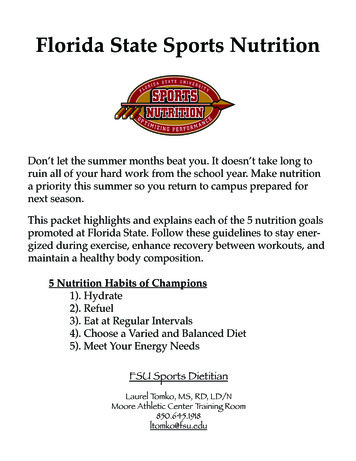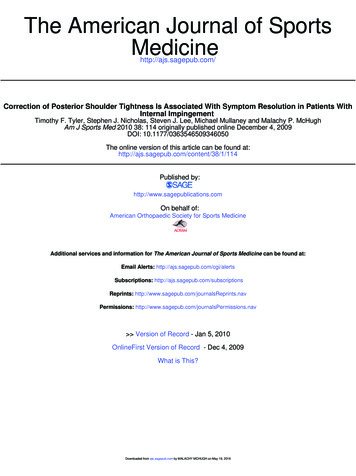
Transcription
The American Journal of SportsMedicinehttp://ajs.sagepub.com/Correction of Posterior Shoulder Tightness Is Associated With Symptom Resolution in Patients WithInternal ImpingementTimothy F. Tyler, Stephen J. Nicholas, Steven J. Lee, Michael Mullaney and Malachy P. McHughAm J Sports Med 2010 38: 114 originally published online December 4, 2009DOI: 10.1177/0363546509346050The online version of this article can be found d by:http://www.sagepublications.comOn behalf of:American Orthopaedic Society for Sports MedicineAdditional services and information for The American Journal of Sports Medicine can be found at:Email Alerts: http://ajs.sagepub.com/cgi/alertsSubscriptions: http://ajs.sagepub.com/subscriptionsReprints: ions: http://www.sagepub.com/journalsPermissions.nav Version of Record - Jan 5, 2010OnlineFirst Version of Record - Dec 4, 2009What is This?Downloaded from ajs.sagepub.com by MALACHY MCHUGH on May 19, 2016
Correction of Posterior Shoulder TightnessIs Associated With Symptom Resolution inPatients With Internal ImpingementTimothy F. Tyler,*†‡ PT, ATC, Stephen J. Nicholas,‡ MD, Steven J. Lee,‡ MD,‡‡Michael Mullaney, PT, and Malachy P. McHugh, PhD†‡From PRO Sports Physical Therapy, Scarsdale, New York, and the Nicholas Institute of SportsMedicine and Athletic Trauma, New York, New YorkBackground: Glenohumeral internal rotation deficit (GIRD) and posterior shoulder tightness have been linked to internalimpingement.Purpose: To determine if improvements in GIRD and/or decreased posterior shoulder tightness are associated with a resolutionof symptoms.Study Design: Cohort study; Level of evidence, 3.Methods: Passive internal rotation and external rotation (ER) range of motion (ROM) at 90 of shoulder abduction and posteriorshoulder tightness (cross-chest adduction in side lying) were assessed in 22 patients with internal impingement (11 men, 11women; age 41 13 years). Treatment involved stretching and mobilization of the posterior shoulder. The Simple Shoulder Test(SST) was administered on initial evaluation and discharge. Changes in GIRD, ER ROM, and posterior shoulder tightness werecompared between patients with complete resolution of symptoms versus patients with residual symptoms using independentt tests.Results: Patients had significant GIRD (35 ), loss of ER ROM (23 ), and posterior shoulder tightness (35 ) on initial evaluation (allP .01). Physical therapy (7 2 weeks; range, 3-12 weeks) improved GIRD (26 14 ; P .01), ER ROM loss (14 20 ), andposterior shoulder tightness (27 19 ). The SST improved from 5 3 to 11 1 (P .01). A greater improvement in posteriorshoulder tightness was seen in patients with complete resolution of symptoms (n 12) compared with patients with residualsymptoms (35 vs 18 ; P .05). Improvements in GIRD and ER ROM loss were not different between groups (GIRD, 25 vs 28 ,P .57; ER ROM, 14 vs 15 , P .84).Conclusion: Resolution of symptoms after physical therapy treatment for internal impingement was related to correction ofposterior shoulder tightness but not correction of GIRD.Keywords: impingement; posterior shoulder; glenohumeral internal rotation deficit (GIRD)Glenohumeral internal rotation deficit (GIRD) and posterior shoulder tightness (PST) have been linked to internalimpingement.11 This link between GIRD and/or PST andinternal impingement was based on the original series byBurkhart et al2 4 that was published in the journal Arth roscopy. The mechanism by which GIRD and PST areassociated with internal impingement has been elucidatedin both cadaveric and clinical studies. In cadaveric studies,tightening the posterior capsule by plication has beenshown to increase anterior glenohumeral translationduring flexion and cross-body adduction, cause superiorglenohumeral translation with flexion and external rotation of the glenohumeral joint, and markedly decreaseinternal rotation.5 7 Similarly, GIRD and PST have beendemonstrated in throwing athletes with internal impingement11 and in patients with secondary impingement.14These cadaveric and clinical studies provide support forthe theory that internal impingement results from alteredglenohumeral mechanics secondary to PST. In line withthis theory, arthroscopic release of the posterior capsulein patients with painful throwing shoulders was shown toprovide symptomatic relief and allow successful return topreinjury sport levels.17Considering that the majority of patients with internalimpingement are initially treated nonsurgically, it is important*Address correspondence to Timothy F. Tyler, PT, ATC, 2 Overhill Road,Scarsdale, NY 10583 (e-mail: tyler@nismat.org).Presented at the 34th annual meeting of the AOSSM, Orlando, Florida,July 2008.No potential conflicts of interest declared.The American Journal of Sports Medicine, Vol. 38, No. 1DOI: 10.1177/0363546509346050 2010 The Author(s)114Downloaded from ajs.sagepub.com by MALACHY MCHUGH on May 19, 2016
Vol. 38, No. 1, 2010Posterior Shoulder Tightness and Internal Impingement 115to establish if a treatment focused on mobilizing and stretching the posterior shoulder provides successful outcomes.Traditionally, the treatment focus has been on resolvingGIRD with less attention paid to PST. The extent to whichimprovements in glenohumeral internal rotation range ofmotion (ROM) versus improvements in posterior shoulderextensibility are associated with successful resolution ofinternal impingement is unknown. Therefore, the purpose ofthis study was to determine if improvements in GIRD and/or decreased PST after a course of physical therapy are associated with a resolution of symptoms in patients with internal impingement. We hypothesized that symptom resolutionwould be associated with decreased PST.stabilized in a retracted position. From a position of 90 ofhumeral abduction and neutral humeral rotation, the tester passively lowered the arm into horizontal adduction bygripping the participant’s forearm just distal to the humeralepicondyles. The arm was lowered until the humeral horizontal adduction end range was reached or until thehumerus started to rotate internally. At this end ROM, asecond tester recorded the angle of the humerus in degreesrelative to the horizontal plane. A positive number indicated tightness, that is, the arm was above the horizontalplane. Previously, PST has been documented with this testby measuring the distance between the medial epicondyleof the elbow and the table on which the patient is lying onhis or her side, with a larger number indicating tightness.However, intersubject differences in trunk and chest widthare confounding factors. Therefore, an angular measurement was used here to control for differences in the size ofthe patients (eg, women with a small frame vs men with alarge frame). A digital level was used for all measurements(Smart Tool Technology, Oklahoma City, Oklahoma).METHODSTwenty-two patients (11 men and 11 women; age, 41 13years) with a diagnosis of internal impingement (18 indominant arms, 4 in nondominant arms) were studied. Theaverage duration of symptoms was 5 5 months with arange of 1 to 24 months. The sports or activities primarilyresponsible for the injuries are listed in Table 1. Six patientshad a superior labrum, anterior and posterior (SLAP) repairmore than 6 months before this study and presented currently with residual internal impingement. The other 16patients had no previous surgery on the involved shoulder.The diagnostic criteria described by Heyworth andWilliams8 for internal impingement was used in this study.The diagnosis was made by an orthopaedic surgeon experienced in treating shoulder injuries (S.J.N.). Specific inclusion criteria based on physical examination were positiverelocation test, positive posterior impingement sign, andposterior glenohumeral joint line tenderness. Specific inclusion criteria based on MRI findings were the presence of aposterosuperior glenoid labral lesion. Exclusion criteriawere anterior instability, full-thickness rotator cuff tear,and subacromial impingement as determined by physicalexamination and MRI. Additionally, all patients reportedsubjective clicking in their shoulder on active movement.Four of the 22 patients had subtle anterior instability withno frank instability.ProceduresAt initial evaluation GIRD, PST, and external rotation ROMwere documented for all patients. Patients also completedthe Simple Shoulder Test (SST) questionnaire. After a courseof physical therapy all measures were repeated and a posttreatment SST score was obtained. All subjects gave informedconsent and the study was approved by institutional rev iew board.Measurement of Posterior Shoulder TightnessThe PST was measured with the patient in the side-lyingposition.12,14,15 The patient laid with the thorax aligned perpendicular to the treatment table and the spine in neutralflexion, extension, and rotation. With the tester facing thepatient, the lateral border of the scapula was manuallyGlenohumeral Internal and External Range of MotionGlenohumeral internal and external rotation ROM wasmeasured with the patient supine, the arm abducted to90 , and the elbow flexed to 90 . The forearm was held insupination and the digital level was placed on the dorsalaspect of the forearm for external rotation ROM and theventral aspect of the forearm for internal rotation. Also, forinternal rotation the scapula was monitored by palpatingthe spine of the scapula with the fingers and the coracoidwith the thumb of that same hand while the opposite handmoved the tested arm into internal rotation.16 For eachmeasurement the arm was rotated passively to the end ofthe ROM. The ROM measurements were made with a digital level as opposed to a goniometer; therefore, it is important to appreciate the reliability of the measurements. Therepeated measures on the noninvolved arm (pretreatmentand posttreatment) provided an indication of measurement reliability. Test-retest Pearson product moment correlations were r .69 for external rotation, r .70 forinternal rotation, and r .89 for PST.Glenohumeral rotation and PST measurements weremade bilaterally and the same tester made all measurements, blinded to previous measurements.InterventionPatients were seen in the clinic 3 times a week and alsoprescribed a daily home exercise program. The primarycomponent of the physical therapy intervention was manual mobilization and stretching of the posterior shoulder.Specific exercises included grade IV posterior glides of theglenohumeral joint in the scapular plane as described byMaitland10 and in maximum glenohumeral internal rotation in 90 shoulder abduction9 (Figure 1), active-assistedcross-chest adduction with manual stabilization of thescapula1 (Figure 2), and the “sleeper stretch” (Figure 3). Alsoincluded were external rotation and scapular-stabilizationstrengthening exercises. The home exercise program includedDownloaded from ajs.sagepub.com by MALACHY MCHUGH on May 19, 2016
116 Tyler et alThe American Journal of Sports MedicineTABLE 1Study Population Injury erIce skating (fall)Weight liftingSwimmingBasketballTennisTennisIce ight eSLAPSLAPNoneNoneNoneNoneNoneNoneSLAPNoneSLAPPST 69313–311106161020–262271749 6–10512–715 2312 39 5312 11129129911912aPST, posterior shoulder tightness; Pre, before treatment; Post, after treatment; GIRD, glenohumeral internal rotation deficit; SST, simpleshoulder test; SLAP, superior labrum, anterior and posterior repair; Dom, dominant arm; Nondom, nondominant arm.Figure 1. A, posterior glide in maximal passive, internal rotation range of motion with the humerus in the plane of the scapular.B, technique to provide distraction with a posterior glide at 90 of abduction. This is the authors’ preferred technique to providelow load long duration mobilization.the sleeper stretch, cross-chest adduction, external rotation, and scapular strengthening exercises. Physical therapy was continued until symptom relief and return to fullactivities or until a plateauing effect was apparent andpatients were referred back to their physician.and “no” responses regarding symptoms and function withactivities of daily living and functional tasks.Outcome MeasureBased on the authors’ clinical experience it was expectedthat some patients would have complete resolution of symptoms and some would have residual symptoms. The SSTscore is a 0 to 12 score. Because it was expected that manyThe SST was administered on initial evaluation and discharge. This is a 12-component questionnaire with “yes”Data AnalysisDownloaded from ajs.sagepub.com by MALACHY MCHUGH on May 19, 2016
Vol. 38, No. 1, 2010Posterior Shoulder Tightness and Internal Impingement 117Figure 2. Cross-chest adduction with manual stabilization ofthe scapula at the acromion and the inferior angle.data are not available in the literature, the intersubjectvariability in GIRD and PST was used; it was assumed thatthese factors would be similar between groups before treatmentand, thus, posttreatment measures would reflect treatmenteffects. Based on previously reported intersubject variabilityin GIRD for patients with shoulder impingement,14 it wasestimated that an 11 difference in GIRD between patientswith residual symptoms and patients with resolution ofsymptoms could be detected with 80% power at P .05 in asample of 20 patients (assuming relatively equal group sizes).The modified PST measurement used here (angular vs linear measurement) was used previously to document PST inpatients with various shoulder lesions (C. J. Johnson, M. J.Mullaney, and M. P. McHugh, unpublished data, 2007).Based on those data it was estimated that an 8 differencein GIRD between patients with residual symptoms andpatients with resolution of symptoms could be detected with80% power at P .05 in a sample of 20 patients (assumingrelatively equal group sizes).RESULTSFigure 3. Sleeper stretch.patients would score 12 after treatment (complete resolution) and the range of scores would be quite small, it wasdetermined that it would be more appropriate to categorizepatients based on their final SST score rather than treat itas a continuous variable. Therefore, changes in GIRD andPST with physical therapy were compared between patientswith and without residual symptoms using a mixed modelanalysis of variance, with Treatment (pretreatment vsposttreatment) as the within-subjects factor and Group(patients with complete resolution of symptoms vs patientswith residual symptoms) as the between-subjects factor.These analyses provided a determination of how improvements in GIRD and PST affected treatment outcome.Measurement reliability for glenohumeral internal andexternal rotation ROM and PST was documented by computing the standard error of the measurement for repeatedmeasures (pretreatment vs final follow-up) of the noninvolved arm.The optimal sample size estimate for this study would bebased on the documented intersubject variability in thechange in GIRD and PST with treatment. Because suchBefore treatment, the SST score for the patient sample was5 3 (of a maximum score of 12). Patients had significantGIRD (35 19 , P .001), loss of external rotation ROM(23 35 , P .001), and increased PST (35 21 , P .001)(data are differences between the involved and noninvolved sides for each test with a positive number indicating loss of motion on the involved side). Pretreatment SSTscore was correlated with PST (r .42, P .05) with lowerSST scores associated with greater PST. Glenohumeralinternal rotation deficit and loss of external rotation ROMwere not correlated with the SST score (r .09, P .69and r .23, P .3, respectively).The average duration of physical therapy was 7 2 weeks(range, 3-12 weeks). There was a significant improvementin SST scores (5 3 to 11 1, P .01), with 12 patientshaving complete resolution of symptoms (12 of 12) and 10patients having residual symptoms (9 of 12 in 4 patientsand 11 of 12 in 6 patients). The residual symptoms reportedon the SST at final follow-up were relatively consistentamong the patients. Seven of 10 patients gave a negativeresponse to the question, “Do you think you can toss a softball overhand 20 yards with the affected extremity?” Fourof 10 patients gave a negative response to the question,“Can you wash the back of your opposite shoulder withyour affected extremity?” Nine of the 10 patients withresidual symptoms gave a negative response to 1 or both ofthese questions.Glenohumeral internal rotation deficit, PST, and loss ofexternal rotation ROM were all significantly improved afterthe period of physical therapy (P .01). At final follow-upGIRD was 9 12 (deficit P .01), PST was 7 13 (deficit P .05), and loss of external rotation ROM was 9 21 (deficit P .06). Improvement in PST was greater inpatients who had complete resolution of symptoms versuspatients with residual symptoms (P .05) (Figure 4).Improvements in GIRD (Figure 5) and external rotationROM (Figure 6) were not different between groups (P .57Downloaded from ajs.sagepub.com by MALACHY MCHUGH on May 19, 2016
118 Tyler et al60The American Journal of Sports Medicinepts with symptom resolutionpts with residual symptomsROM Deficit (deg)504030P .12Effect of Treatment P .0001Group by Treatment P .0520P .05P .9910DISCUSSION0Pre TreatmentPost TreatmentImprovementFigure 4. Effect of treatment on posterior shoulder tightness inpatients with and without resolution of symptoms. Mean andstandard error for involved/uninvolved deficits are shown.5045pts with symptom resolutionpts with residual symptomsP .32ROM Deficit (deg)40P .5735Effect of Treatment P .0001Group by Treatment P .57302520P .24151050Pre TreatmentPost TreatmentImprovementFigure 5. Effect of treatment on glenohumeral internal rotation deficit in patients with and without resolution of symptoms. Mean and standard error for involved/uninvolveddeficits are shown.pts with symptom resolutionpts with residual symptoms45ROM Deficit (deg)4035Effect of Treatment P .01P .72Group by Treatment P .8430P .842520P .32151050patients with complete resolution of symptoms and 5 3months for patients with residual symptoms (P .36).The standard error of the measurement was 4.0 for bothglenohumeral internal and external rotation ROM, and4.2 for PST, indicating good reliability for these measuresrepeated over a period of several weeks.Pre TreatmentPost TreatmentImprovementFigure 6. Effect of treatment on loss of external rotationrange of motion in patients with and without resolution ofsymptoms. Mean and standard error for involved/uninvolveddeficits are shown.and P .84, respectively). The average improvement inPST for all 22 patients was 27 . Nine of 12 patients (75%)with complete resolution of symptoms improved their PSTby at least 27 compared with 2 of 10 patients (20%) withresidual symptoms (P .05). The average improvement inGIRD was 26 . Six of 12 patients (50%) with resolution ofsymptoms had improved GIRD by at least 26 comparedwith 5 of 10 patients (50%) with residual symptoms (P .99). The duration of symptoms was 7 7 months forThe physical therapy treatment intervention focusing onstretching and mobilizing the posterior shoulder resulted ina decrease in PST, a decrease in GIRD, a decrease
of physical therapy all measures were repeated and a post-treatment SST score was obtained. All subjects gave informed consent and the study was approved by institutional rev-iew board. Measurement of Posterior Shoulder Tightness The PST was measured with the patient in the side-lying positi
